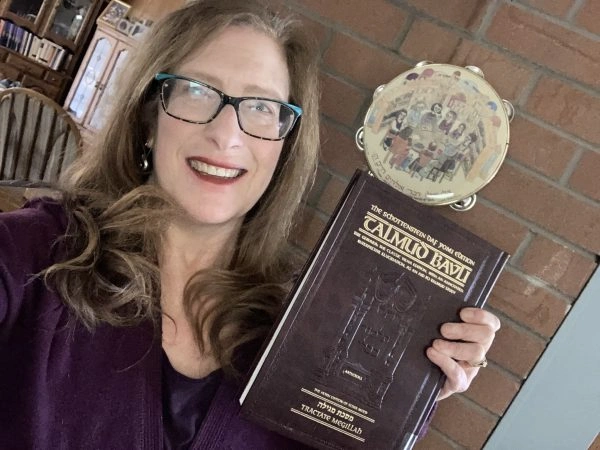Bava Batra 98
מְבוּשָּׂם אֲנִי מוֹכֵר לָךְ״ – חַיָּיב לְהַעֲמִיד לוֹ עַד הָעֲצֶרֶת. וְ״יָשָׁן״ – מִשֶּׁל אֶשְׁתָּקַד, וּ״מְיוּשָּׁן״ – מִשֶּׁל שָׁלֹשׁ שָׁנִים.
that is spiced, which is preserved and of lasting quality, that I am selling to you, then he bears financial responsibility to provide him with wine that will keep until the festival of Shavuot. And if the seller said: I am selling you old wine, he is responsible to provide wine from the previous year. And if he said: I am selling you aged wine, he is responsible to provide wine that is from three years earlier.
גְּמָ׳ אָמַר רַבִּי יוֹסֵי בְּרַבִּי חֲנִינָא: לֹא שָׁנוּ אֶלָּא בְּקַנְקַנִּים דְּלוֹקֵחַ, אֲבָל בְּקַנְקַנִּים דְּמוֹכֵר – אָמַר לֵיהּ: הָא חַמְרָךְ וְהָא קַנְקַנָּךְ.
GEMARA: Rabbi Yosei, son of Rabbi Ḥanina, says: When they taught that the seller does not bear responsibility if the wine sours, that was only if it soured while in the jugs of the buyer; but if it soured in the jugs of the seller, then the buyer could say to him: This is your wine and this is your jug; take it and reimburse me. Since it soured while still in the original jugs, it was clearly flawed from the outset.
וְכִי קַנְקַנִּין דְּמוֹכֵר מַאי הָוֵי? לֵימָא לֵיהּ: לָא אִיבְּעִי לָךְ לְשַׁהוֹיֵי! לָא צְרִיכָא, דַּאֲמַר לֵיהּ לְמִקְפָּה.
The Gemara asks: But even if the wine soured while in the jugs of the seller, what of it? Let the seller say to the buyer: You should not have left it for so long after purchasing it; I should not be responsible just because you chose to do so. The Gemara answers: No, this ruling is necessary in a case where the buyer had said to him that he was purchasing the wine for cooking, in which case it is understood that he needs it to maintain its quality over a longer period of time, as only a small amount is used each time.
וּמַאי דּוּחְקֵיהּ דְּרַבִּי יוֹסֵי בְּרַבִּי חֲנִינָא לְאוֹקֹמַהּ לְמַתְנִיתִין בְּקַנְקַנִּין דְּלוֹקֵחַ – וְדַאֲמַר לֵיהּ לְמִקְפָּה? לוֹקְמֵהַּ בְּקַנְקְנִּין דְּמוֹכֵר, וּדְלָא אֲמַר לֵיהּ לְמִקְפָּה!
The Gemara asks: And what impelled Rabbi Yosei, son of Rabbi Ḥanina, to interpret the mishna as referring to a case where the wine soured while in the jugs of the buyer, and where he had said to him that he wanted the wine for cooking? Instead, let him interpret it as referring to a case where the wine soured while in the jugs of the seller, and to where he had not said to him that he wanted the wine for cooking.
אָמַר רָבָא: מַתְנִיתִין קְשִׁיתֵיהּ, דְּקָתָנֵי: אִם יָדוּעַ שֶׁיֵּינוֹ מַחְמִיץ – הֲרֵי זֶה מִקָּח טָעוּת. אַמַּאי? לֵימָא לֵיהּ: לָא אִיבְּעִי לָךְ לְשַׁהוֹיֵי! אֶלָּא לָאו שְׁמַע מִינַּהּ דַּאֲמַר לֵיהּ לְמִקְפָּה? שְׁמַע מִינַּהּ.
In explanation, Rava said: The mishna was difficult for him, as it teaches in the following clause: But if it is known of this seller that his wine always sours, then this sale is a mistaken transaction. With regard to this clause one could ask: Why is that so? Let the seller say to him: You should not have left it for so long after purchasing it. Rather, isn’t it correct to conclude from that clause that the mishna is referring to a case where the buyer had said to him that he wants the wine for cooking? The Gemara concludes: Yes, one can conclude from it that this is so.
וּפְלִיגָא דְּרַב חִיָּיא בַּר יוֹסֵף – דְּאָמַר רַב חִיָּיא בַּר יוֹסֵף: חַמְרָא – מַזָּלָא דְמָרֵיהּ גָּרֵים, שֶׁנֶּאֱמַר: ״וְאַף כִּי הַיַּיִן בֹּגֵד, גֶּבֶר יָהִיר וְגוֹ׳״
And Rabbi Yosei, son of Rabbi Ḥanina, disagrees with the opinion of Rav Ḥiyya bar Yosef, as Rav Ḥiyya bar Yosef says: With regard to wine, it is the owner’s poor fortune that causes the wine to go sour, as it is stated: “And moreover, wine is a treacherous dealer; the haughty man abides not” (Habakkuk 2:5), which is interpreted to mean that the wine of a haughty man will betray him, as it will sour as a punishment for his arrogance. Accordingly, since the wine soured after the buyer purchased it, he cannot place the blame upon the seller.
אָמַר רַב מָרִי: הַאי מַאן דִּיהִיר – אֲפִילּוּ אַאִינָשֵׁי בֵיתֵיהּ לָא מִיקַּבַּל, שֶׁנֶּאֱמַר: ״גֶּבֶר יָהִיר וְלֹא יִנְוֶה״ – מַאי ״וְלֹא יִנְוֶה״? בַּנָּוֶה שֶׁלּוֹ.
The Gemara offers additional homiletic interpretations of the verse just cited. Rav Mari said: One who is haughty is not accepted even by the members of his household, as it is stated: “The haughty man abides not” (Habakkuk 2:5). What does the phrase “abides [yinveh] not” mean? It means that even in his abode [naveh], he is not accepted.
אָמַר רַב יְהוּדָה אָמַר רַב: כׇּל הַמִּתְגָּאֶה בְּטַלִּית שֶׁל תַּלְמִיד חָכָם, וְאֵינוֹ תַּלְמִיד חָכָם – אֵין מַכְנִיסִין אוֹתוֹ בִּמְחִיצָתוֹ שֶׁל הַקָּדוֹשׁ בָּרוּךְ הוּא. כְּתִיב הָכָא: ״וְלֹא יִנְוֶה״, וּכְתִיב הָתָם: ״אֶל נְוֵה קׇדְשֶׁךָ״.
Rav Yehuda says that Rav says: With regard to anyone who glorifies himself by wearing a garment of the style worn by a Torah scholar, but in reality he is not a Torah scholar, he will not be brought within the boundary of the Holy One, Blessed be He, in the World-to-Come. This is alluded to by the fact that it is written in the verse here: “Abides [yinveh] not,” and the meaning of the word yinveh may be derived from that which is written in a verse there: “To Your holy habitation [neveh]” (Exodus 15:13).
אָמַר רָבָא: הַאי מַאן דְּזַבֵּין לֵיהּ חָבִיתָא דְחַמְרָא לְחַנְוָאָה אַדַּעְתָּא לְסַבּוֹיֵיהּ, וּתְקֵיף אַפַּלְגָא אוֹ אַתִּילְּתָא, דִּינָא הוּא דִּמְקַבֵּל לַהּ מִינֵּיהּ. וְלָא אֲמַרַן אֶלָּא דְּלָא שַׁנִּי בְּבַרְזָא, אֲבָל שַׁנִּי בְּבַרְזָא – לָא. וְלָא אֲמַרַן אֶלָּא דְּלָא מְטָא יוֹמָא דְשׁוּקָא, אֲבָל מְטָא יוֹמָא דְשׁוּקָא – לָא.
Rava says: In the case of one who sells a barrel of wine to a shopkeeper with the understanding that the wine will be for serving to the shopkeeper’s customers and that he will be liable to pay the seller only once the barrel is finished, and the wine spoiled when one-half or one-third of the wine still remained, the halakha is that the seller must accept back the remaining wine from the shopkeeper, as the shopkeeper is liable to pay only for the wine that he sells. And we stated this halakha only in a case where the shopkeeper had not switched the tap of the barrel; but if he had switched the tap, the seller does not have to take the wine back and the shopkeeper must pay for it all. And furthermore, we stated this halakha only where the wine soured before the market day arrived and the shopkeeper did not have the opportunity to sell the entire barrel; but if the wine was still of good quality when the market day arrived, then the seller does not have to take the wine back.
וְאָמַר רָבָא: הַאי מַאן דְּקַבֵּיל חַמְרָא אַדַּעְתָּא דְּמַמְטֵי לֵיהּ לְפַרְווֹתָא דְּ״ווֹל שָׁפָט״, וְאַדְּמָטֵי הָתָם זָל; דִּינָא הוּא דִּמְקַבֵּל לֵיהּ.
And Rava says: In the case of a vintner who enters a business venture with another person who will sell the wine for him and afterward they will split the profits, then if this middleman who receives the wine to sell does so with the understanding that he will bring it to the port of the city of Vol Shefat and sell it only there, and before he arrives there the price of the wine drops, the halakha is that the vintner must accept the loss.
אִיבַּעְיָא לְהוּ: הֲוָה חַלָּא, מַאי? אֲמַר לֵיהּ רַב הִלֵּל לְרַב אָשֵׁי: כִּי הֲוַאן בֵּי רַב כָּהֲנָא, אֲמַר לַן: חַלָּא לָא, וּדְלָא כְּרַבִּי יוֹסֵי בְּרַבִּי חֲנִינָא.
With regard to the previous case, a dilemma was raised before the Sages: If the wine becomes vinegar before he reaches Vol Shefat, what is the halakha? Rav Hillel said to Rav Ashi: When we were in the study hall of Rav Kahana, he said to us: If the wine becomes vinegar, the vintner does not have to accept the loss; and this is not in accordance with the opinion of Rabbi Yosei, son of Rabbi Ḥanina, who holds that as long as the wine is in the jug of the seller he is able to return it to the seller. The reason for this is that it is possible that the poor fortune of the middleman caused it to sour.
וְאִיכָּא דְּאָמְרִי: אֲפִילּוּ חַלָּא נָמֵי מְקַבֵּל. כְּמַאן? כְּרַבִּי יוֹסֵי בְּרַבִּי חֲנִינָא.
And there are those who say that even if the wine turns into vinegar, the vintner must also accept the loss. In accordance with whose opinion is this? It is in accordance with the opinion of Rabbi Yosei, son of Rabbi Ḥanina.
״יָשָׁן״ – מִשֶּׁל אֶשְׁתָּקַד כּוּ׳.
The mishna teaches: If the seller said: I am selling you old wine, he is responsible to provide wine from the previous year. And if he said: I am selling you aged wine, he is responsible to provide wine that is from three years earlier.
תָּאנָא: וּמְיַישֵּׁן וְהוֹלֵךְ עַד הַחַג.
It is taught in a baraita: And where he sold him aged wine, he is responsible to provide wine that will continue to age, i.e., maintain its quality, until the festival of Sukkot.
מַתְנִי׳ הַמּוֹכֵר מָקוֹם לַחֲבֵירוֹ, וְכֵן הַמְקַבֵּל מָקוֹם מֵחֲבֵירוֹ לַעֲשׂוֹת לוֹ בֵּית חַתְנוּת לִבְנוֹ וּבֵית אַלְמְנוּת לְבִתּוֹ – בּוֹנֶה אַרְבַּע אַמּוֹת עַל שֵׁשׁ, דִּבְרֵי רַבִּי עֲקִיבָא. רַבִּי יִשְׁמָעֵאל אוֹמֵר: רֶפֶת בָּקָר הִיא זוֹ!
MISHNA: With regard to one who sells a plot of land to another, with the buyer intending to build a bridal house for his son or a widowhood home for his daughter on that plot, and similarly, with regard to a contractor who receives a plot of land from another under a commission to build for the owner on that land a bridal house for his son, or a widowhood home for his daughter, the terms of the transaction are a matter of dispute. The mishna presents the dispute: In the latter case, the contractor must build a building that is at least four cubits by six cubits in size, and similarly, in the case of the sale, the seller must provide a plot of land that can accommodate a building of that size; this is the statement of Rabbi Akiva. Rabbi Yishmael says: A structure of this size is a cowshed, and a bridal house or a widowhood home is larger than that.
הָרוֹצֶה לַעֲשׂוֹת רֶפֶת בָּקָר – בּוֹנֶה אַרְבַּע אַמּוֹת עַל שֵׁשׁ.
One who wants to construct a cowshed builds a structure at least four cubits by six cubits in size.
בַּיִת קָטָן – שֵׁשׁ עַל שְׁמוֹנֶה, גָּדוֹל – שְׁמוֹנֶה עַל עֶשֶׂר, טְרַקְלִין – עֶשֶׂר עַל עֶשֶׂר. רוּמוֹ כַּחֲצִי אׇרְכּוֹ וְכַחֲצִי רׇחְבּוֹ. רְאָיָה לַדָּבָר – רַבָּן שִׁמְעוֹן בֶּן גַּמְלִיאֵל אוֹמֵר: כְּבִנְיַן הַהֵיכָל.
The mishna delineates the standard dimensions for various other structures. A small house is six by eight cubits. A large house is eight by ten cubits. A banquet hall [teraklin] is ten by ten cubits. The standard height for each of these structures is equal to the sum of half its length and half its width. There is a proof of the matter; Rabban Shimon ben Gamliel says: The proportions are like the building of the Sanctuary; it was forty cubits wide and twenty cubits long and its height was thirty cubits, which is the sum of half the width and half the length.
גְּמָ׳ לְמָה לִי לְמִיתְנָא ״בֵּית חַתְנוּת לִבְנוֹ, וּבֵית אַלְמְנוּת לְבִתּוֹ״? לִיתְנֵי ״בֵּית חַתְנוּת לִבְנוֹ וּלְבִתּוֹ, וּבֵית אַלְמְנוּת לִבְנוֹ וּלְבִתּוֹ״! מִלְּתָא אַגַּב אוֹרְחֵיהּ קָא מַשְׁמַע לַן, דְּלָא דַּרְכָּא דְחַתְנָא לְמֵידַר בֵּי חֲמוּהּ –
GEMARA: Why do I need the mishna to teach specifically: A bridal house for his son, and: A widowhood home for his daughter? Instead, let it teach: A bridal house for his son or his daughter, and a widowhood home for his son or his daughter. The Gemara answers: It teaches us a matter in passing, that it is not the proper manner of conduct for a son-in-law to live in his father-in-law’s home. Therefore, it is the father of the groom who generally provides a bridal home for the couple and the bride will return to live near her parents’ house only if she is widowed or divorced.
כְּדִכְתִיב בְּסֵפֶר בֶּן סִירָא: הַכֹּל שָׁקַלְתִּי בְּכַף מֹאזְנַיִם, וְלֹא מָצָאתִי קַל מִסּוּבִּין; וְקַל מִסּוּבִּין – חָתָן הַדָּר בְּבֵית חָמִיו; וְקַל מֵחָתָן – אוֹרֵחַ מַכְנִיס אוֹרֵחַ; וְקַל מֵאוֹרֵחַ – מֵשִׁיב דָּבָר בְּטֶרֶם יִשְׁמָע – שֶׁנֶּאֱמַר: ״מֵשִׁיב דָּבָר בְּטֶרֶם יִשְׁמָע אִוֶּלֶת הִיא לוֹ וּכְלִמָּה״.
Support for this is as it is written in the book of ben Sira: I have weighed everything in the pan of a balance scale and I have not found anything inferior to bran; but inferior to bran is a son-in-law who lives in his father-in-law’s house; and inferior to a son-in-law is a guest who brings in a guest; and inferior to a guest is one who answers a matter before he listens. As it is stated: “He that gives an answer before he listens, it is folly for him and a disgrace” (Proverbs 18:13).
רַבִּי יִשְׁמָעֵאל אוֹמֵר: רֶפֶת בָּקָר הִיא זוֹ! הָרוֹצֶה לַעֲשׂוֹת כּוּ׳. רֶפֶת בָּקָר מַאן קָתָנֵי לַהּ? אִיכָּא דְּאָמַר רַבִּי יִשְׁמָעֵאל קָתָנֵי לַהּ, וְאִיכָּא דְּאָמַר רַבִּי עֲקִיבָא קָתָנֵי לַהּ.
§ The mishna teaches: Rabbi Yishmael says: A structure of this size is a cowshed. And then the mishna continues: One who wants to construct a cowshed builds a structure at least four cubits by six cubits in size. The Gemara asks: Who teaches this subsequent clause about a cowshed? There is a Sage who says that Rabbi Yishmael teaches it and it is an elaboration of his statement. And there is a Sage who says that Rabbi Akiva teaches it in response to Rabbi Yishmael’s statement.
אִיכָּא דְּאָמַר רַבִּי עֲקִיבָא קָתָנֵי לַהּ – וְהָכִי קָאָמַר: אַף עַל פִּי שֶׁרֶפֶת בָּקָר הִיא, פְּעָמִים שֶׁאָדָם עוֹשֶׂה דִּירָתוֹ כְּרֶפֶת בָּקָר. וְאִיכָּא דְּאָמַר רַבִּי יִשְׁמָעֵאל קָתָנֵי לַהּ – וְהָכִי קָאָמַר: שֶׁהָרוֹצֶה לַעֲשׂוֹת רֶפֶת בָּקָר, עוֹשֶׂה אַרְבַּע אַמּוֹת עַל שֵׁשׁ.
The Gemara elaborates: There is a Sage who says that Rabbi Akiva teaches it, and this is what Rabbi Akiva is saying: Even though this structure is of the same dimensions as a cowshed, nevertheless, since there are times when a person constructs his home as small as a cowshed, a contractor has fulfilled his commission if he builds a house to such dimensions. And there is a Sage who says that Rabbi Yishmael teaches it, and this is what Rabbi Yishmael is saying to Rabbi Akiva: The dimensions that you stated are clearly not the correct dimensions for a bridal house or widowhood home, as one who wants to construct a cowshed constructs a structure of four cubits by six cubits. A house for human dwelling is certainly larger than that.
טְרַקְלִין עֶשֶׂר עַל עֶשֶׂר. מַאי טְרַקְלִין? קוּבְּתָא בֵּי וַורְדֵי.
§ The mishna teaches: A banquet hall is ten by ten cubits. The Gemara clarifies: What is a banquet hall? A pavilion of roses.
תָּאנֵי: וְקַנְתֵּיר – שְׁתֵּים עֶשְׂרֵה עַל שְׁתֵּים עֶשְׂרֵה. מַאי קַנְתֵּיר? תַּרְבֵּץ אַפַּדְנֵי.
It is taught in a baraita: The standard size of a kanteir is twelve by twelve cubits. The Gemara clarifies: What is a kanteir? It is a decorative courtyard of a mansion.
רוּמוֹ כַּחֲצִי אׇרְכּוֹ וְכַחֲצִי רׇחְבּוֹ, רְאָיָה לַדָּבָר – רַבָּן שִׁמְעוֹן בֶּן גַּמְלִיאֵל אוֹמֵר: כְּבִנְיַן הַהֵיכָל. ״רְאָיָה לַדָּבָר״ מַאן קָתָנֵי לַהּ? אִיכָּא דְּאָמַר רַבָּן שִׁמְעוֹן בֶּן גַּמְלִיאֵל קָתָנֵי לַהּ – וְהָכִי קָאָמַר: רְאָיָה לַדָּבָר מִנַּיִן? אָמַר רַבָּן שִׁמְעוֹן בֶּן גַּמְלִיאֵל: הַכֹּל כְּבִנְיַן הֵיכָל.
The mishna teaches: The standard height for each of these structures is equal to the sum of half its length and half its width. There is a proof of the matter; Rabban Shimon ben Gamliel says: The proportions are like the building of the Sanctuary. The Gemara asks: Who teaches the phrase: Proof of the matter? There is a Sage who says that Rabban Shimon ben Gamliel teaches it, and this is what he is saying: From where can a proof of the matter be derived? The mishna then cites that Rabban Shimon ben Gamliel said that everything is like the building of the Sanctuary.
וְאִיכָּא דְּאָמַר תַּנָּא קַמָּא קָתָנֵי לַהּ – וְרַבָּן שִׁמְעוֹן בֶּן גַּמְלִיאֵל אַתְמוֹהֵי קָא מַתְמַהּ, וְהָכִי קָאָמַר לֵיהּ [לְתַנָּא קַמָּא]: רְאָיָה מִנַּיִן – מִבִּנְיַן הֵיכָל?! אַטּוּ כּוּלֵּי עָלְמָא כְּבִנְיַן הֵיכָל עָבְדִי?
And there is a Sage who says that the first tanna teaches it, and, understanding that the proof the tanna wished to cite was from the example of the Sanctuary, Rabban Shimon ben Gamliel interjected and expressed astonishment at the idea. And this is what Rabban Shimon ben Gamliel is saying to the first tanna: From where do you derive a proof? Do you derive it from the building of the Sanctuary? Is that to say that everyone constructs their buildings like the building of the Sanctuary? Why should they do so?
תַּנְיָא, אֲחֵרִים אוֹמְרִים: רוּמוֹ – כְּקוֹרוֹתָיו. וְלֵימָא: רוּמוֹ כְּרׇחְבּוֹ! אִיבָּעֵית אֵימָא: בֵּיתָא מֵעִילַּאי רָוַוח, וְאִיבָּעֵית אֵימָא: מִשּׁוּם דְּאִיכָּא בֵּי כַוֵּוי.
It is taught in a baraita: Aḥerim say: The standard height of each of these structures is equal to the length of its crossbeams. The Gemara suggests: And let us say more simply that its height is equal to its width. The Gemara answers: If you wish, say that formulating the ruling in this way is necessary, because the space inside a house widens at the top, as the walls get thinner toward the top and the crossbeams are actually longer than the width of the floor of the building. And if you wish, say instead that formulating it in this way is necessary because there are indentations in the wall into which the crossbeams are inserted. The crossbeams are consequently longer than the space inside the house.
רַבִּי חֲנִינָא נְפַק לְקִרְיָיתָא, רְמוֹ לֵיהּ קְרָאֵי אַהֲדָדֵי – כְּתִיב: ״וְהַבַּיִת אֲשֶׁר בָּנָה הַמֶּלֶךְ שְׁלֹמֹה לַה׳ – שִׁשִּׁים אַמָּה אׇרְכּוֹ, וְעֶשְׂרִים רׇחְבּוֹ, וּשְׁלֹשִׁים אַמָּה קוֹמָתוֹ״; וּכְתִיב: ״וְלִפְנֵי הַדְּבִיר – עֶשְׂרִים אַמָּה אֹרֶךְ, וְעֶשְׂרִים אַמָּה רֹחַב, וְעֶשְׂרִים אַמָּה קוֹמָתוֹ״! אֲמַר לְהוּ: כִּי קָא חָשֵׁיב – מִשְּׂפַת כְּרוּבִים וּלְמַעְלָה.
§ Apropos the building of the Sanctuary, the Gemara relates the following incident: Rabbi Ḥanina once went out to the villages to teach Torah there, and he raised a contradiction between two verses that detail the dimensions of the Sanctuary: It is written: “And the house that King Solomon built for the Lord, was sixty cubits in length, and twenty cubits in width, and its height was thirty cubits” (I Kings 6:2). But it is also written: “And before the partition was twenty cubits in length, and twenty cubits in width, and its height was twenty cubits” (I Kings 6:20). The first verse states that its height was thirty cubits, whereas the second verse states that its height was only twenty cubits. He said to the villagers that the reason for the difference is that when the latter verse calculated the height, it did so from the upper edge of the cherubs and upward, as the cherubs themselves stood ten cubits high.
מַאי קָא מַשְׁמַע לַן?
The Gemara asks: What is the verse teaching us by considering only the area above the cherubs?






















